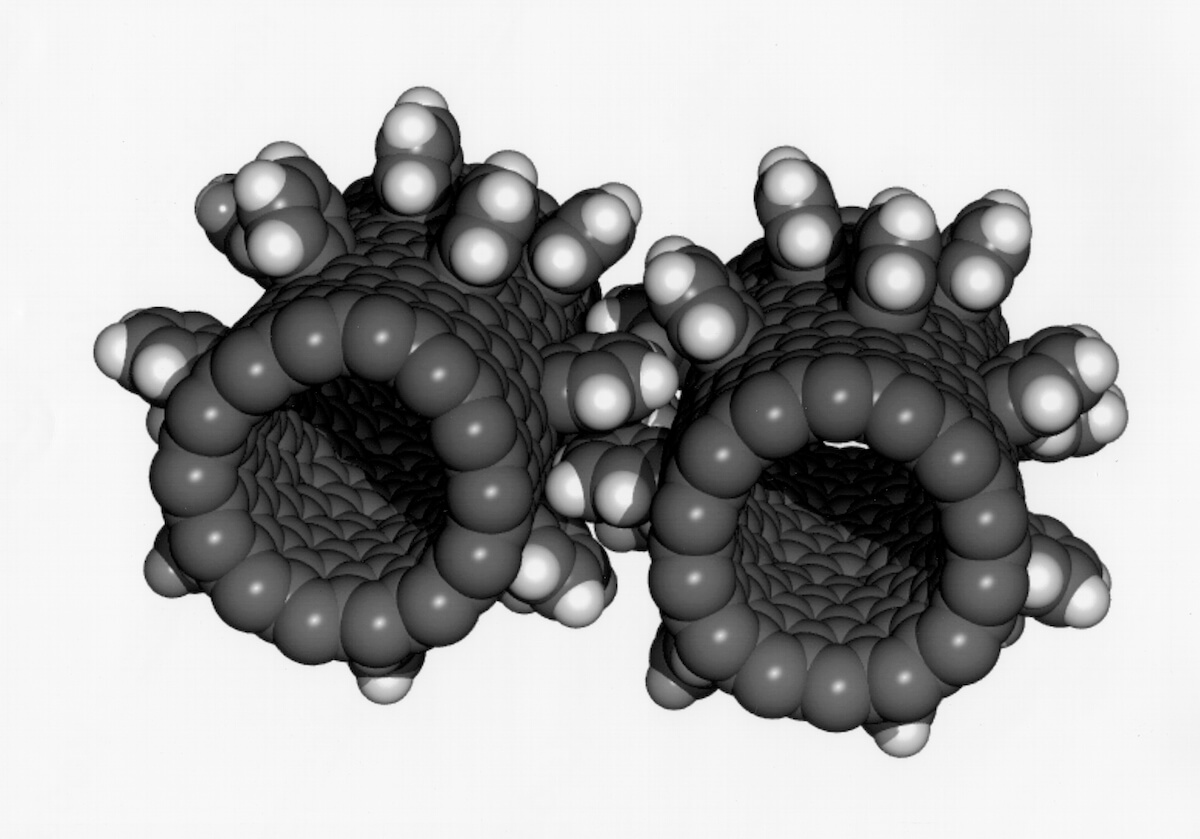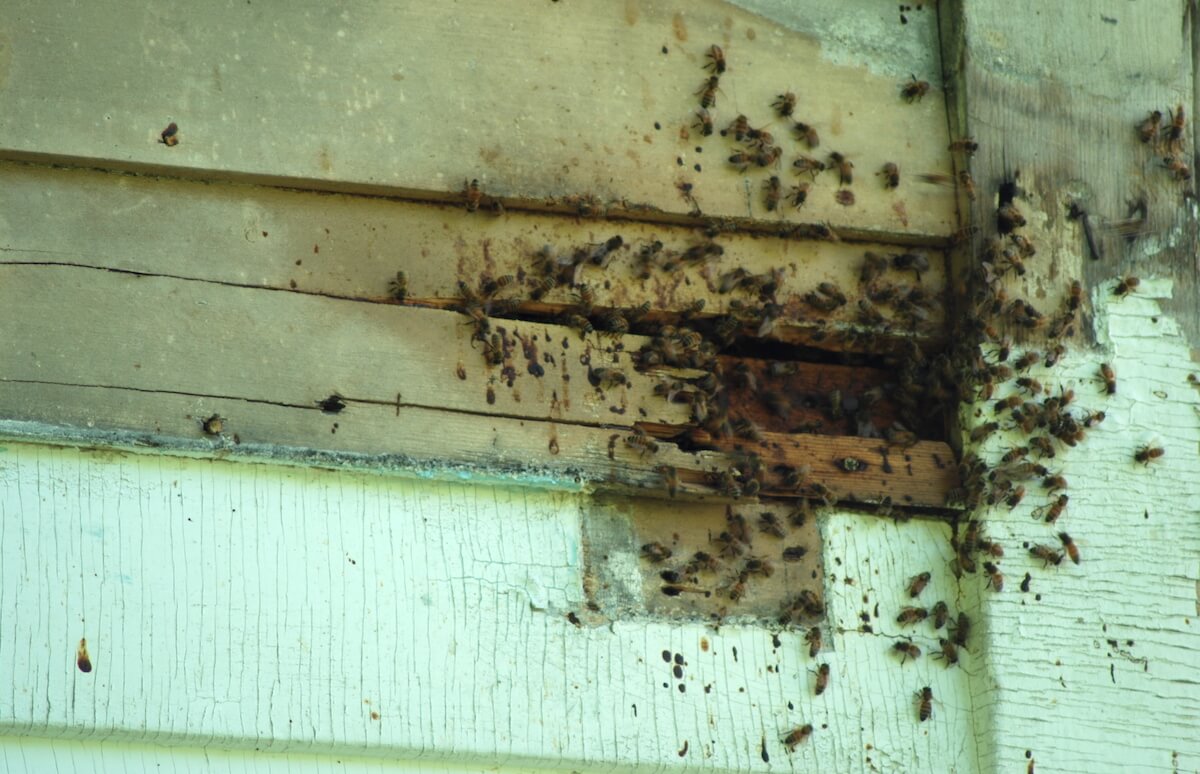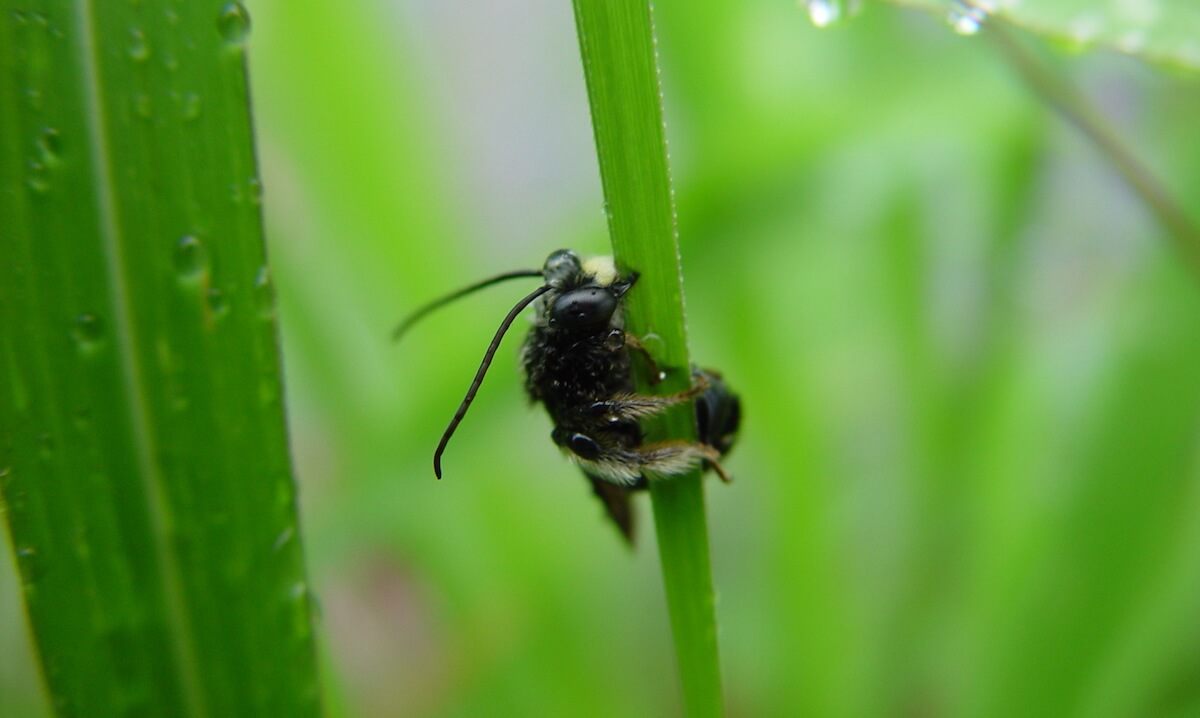
(Editor’s note: Honeyguise is a short story from Oklahoma author Keith Gaddie.)
We never knew it would start with the bees.
We always took the honeybees for granted. The bees buzzed about, pollinating plants. They went back to their hives and made honey in their honeycombs from the nectar they extracted from the sweet plants.
Then, we would find their hives. We would smoke the bees out of the hives and harvest the waxy honeycombs. It was delicious. For thousands of years, people took from the bees. We built them hives, smoking them out from time to time in order to harvest their honey. Some of the earliest cave art shows honey seekers smoking bees from a hive.
We learned to follow a particular bird — called the Greater Honeyguide — that feeds on honeybees. This was the beginning of bird watching.
The honey was good for us. It made us happy. It was sweet. Because of its chemical properties it was good to bake with, and it didn’t hold a lot of microorganisms that might harm us. In some religions, honey became part of ritual feast, of scripture, of mystic beliefs in the offerings to Eternal beings. They say honey nurtured John the Baptist in the wilderness.
This honey came from the bees. We knew the bees would always be there.
Whole industries grew up around the bees and their honey. We could harvest it, package it, and sell it. Beekeeping became a noble profession, a specialty that provided a great luxury.
We later learned that local honey helped fight off local allergies, and it tasted good in tea. It made us want more tea, which was also good for us. Honey pots, honey dippers and honeycombs were made to serve honey production. We made ointments and soothing medicines with honey. We made a literary childhood hero of a stuffed bear who had an entire life built around honey, honey pots and fooling bees.
Man thrived. And man took the honey from the bees.
Plants thrived too. Hundreds of different crop plants depended primarily on the honeybees to assist in pollination. Without the bees, the crop yields would be small, limited, deformed or absent altogether. Billions of dollars were spent by growers to place honeybee pollinators in the fields.
Man thrived.
Pollination declined

But then the bees went away.
We didn’t notice at first. Bees disappearing happened from time to time. But when the bees used to disappear, it was a local phenomenon. A hurricane or a localized weather event — a sudden cold snap — would result in a localized kill-off of the bees. There would be a decline in pollination, and some local farmers wouldn’t have a crop come in the way they expected, with either low yields or stunted fruit. But it was a local thing, and after a few years, the bees came back and so did the crop yields.
Honeybee colonies were perennial. They endured from year to year, tending to their environment. They made cognitive maps of the local area, and communicated these maps to one another. As sources of nectar moved, they would individually correct their maps and communicate this to the larger colony. When people talk about a ‘hive mind,’ it is this behavior that represents empirical evidence.
The honeybees started to die off. And the colonies started to dwindle.
Man did not know why the bees started to die. Initially pesticides were blamed, but the bees were also dying off on organic farms. There wasn’t evidence of pesticide poisoning in the dead colonies.
It wasn’t the weather. Some colonies died in areas where climate change had caused sudden, late spring and winter weather snaps. But those sudden climatic shifts didn’t happen in sub-Saharan Africa, and the honeybee colonies were dying there too.
Researchers at the University of South Carolina started finding foraging worker bees laying about dead anywhere from several yards to several miles from their hive. The kills were huge. A large natural colony will have tens of thousands of bees, and bees were found in the hundreds, dropped dead from the sky. No traces of pesticides were found in the bees. No sudden temperature snaps had occurred. They were just dead.
Similar mass kills were discovered in Europe, Africa and South America. Initially, researchers concluded that the phenomenon only affected Apis mellifera, the most common honeybee in the world and the only honeybees found outside of southeast Asia. But a faculty member from USC, vacationing in Hanoi, reported similar kills in Vietnam, and soon after came reports from China and India of colony decline. Vast swaths of dead bees sometimes covered miles and miles. They called it “colony collapse disorder.” It was in fact a threat of total extinction of one of man’s partners (along with the dog and the horse) in creating civilization.
Within two years, more than two-thirds of the world’s honeybee colonies had disappeared or died. Growers bid up the price for honeybees, placing hives to pollinate their crops, or tried alternatives such as solitary bees (who produce no honey) and bumblebees (who produce only a few days worth of food). Unfortunately, the bumblebees proved more vulnerable to pesticides, and colony collapse also set in on them. Unlike the honeybees, though, there was no evidence of mass kills anywhere except near the colonies.
Within five years, nine of every 10 honeybee colonies had collapsed. Bumblebees were headed for extinction. Solitary bees held out some hope, but the aggressive pests and parasites that once fed on the honeybees turned on the solitary bees. They were unable to endure the onslaught of predators and disease. It turned out that honeybees endured because of numbers and their complex social structure — they had large, resilient colonies that were kept alive through winter. The solitary bees did not preserve the entire colony through winter. Instead, they rebuilt anew every spring. The solitary bees collapsed globally within 18 months.
Pollination declined. Without the aid of the increasingly valued but dwindling honeybees, crop yields fell. When new honeybees were introduced to areas where massive kills and colony collapse had occurred, the new colonies also collapsed within 18 months.
Man confronted a world with no honey and no honeybees. And the balance of man’s complex agricultural economy threatened to collapse.
The last honeybee colony collapsed a year later. Agribusiness bid up the dwindling stock of solitary bees and bumblebees. Crop yields fell. We wondered, how would nature make food without the bees? Grains and grasses would be okay, but man also needed fruit. The sea stocks were not adequate to offset the lost yield of the earth.
Robots to the rescue

Science, thankfully, was on the case. Engineers had spent decades developing nanotechnologies to assist in everything from repairing damaged human tissue to improving computer functions. The advances in extreme miniaturization — reshaping molecular-level matter and building cellular-sized machines — made it possible, in theory, to engineer small-scale robots. The technology was turned to develop a solution filling the role of the departed bees.
This use of micro- and nano-technology to try to replicate biological functions was not novel. Called biomimicry, the practice had been used to repair biological functions in living beings and to augment and improve on what nature made. Nanotechnology had repaired damaged organs like kidneys and hearts. But the technology had not been applied on a large scale toward creating an actual organism to replace another life form.
A proposed micro-machine was pursued. This ‘protobee’ would be built up from cellular-sized nano-machines. Those were composed of nanotechnology-engineered molecular machines. It was developed from a nano-machine template originally created to clear plaque from human arteries. The principle was the same — if the machine could be programmed to find particular substances like pollen, it could harvest it. If it could be made mobile, it could transport the pollen to another plant. The process was known — it was just a matter of engineering, programming and then making the machine mobile.
Programming actually turned out to be the easy part. Researchers at Georgia Tech discovered that, when they reconstructed the baseline code for these functions and attempted to reduce it to a useable size to program into a nano-robot, the code bore a striking resemblance to the DNA structure of a honeybee. They could miniaturize the process. The protobee would be able to detect pollen and also locate a plant in need of pollination, thereby stepping into the honeybee’s critical role.
The problem was mobility. It was possible to create a sufficiently small platform for the protobee to travel in. But energy was a problem. Protobees were only able to fly for 15 minutes at a time. They were difficult to recharge, because rapid recharging of their tiny power packages raised their internal temperatures so high that the underlying nanotechnology just burned up. They could not carry much of a charge if they didn’t burn up, and at best they functioned for a few minutes. At short range, they proved capable pollinators, provided the energy storage issue could be resolved.
The solution to the mobility constraints was found in diabetes research. Biomedical scientists had made major strides in developing remedies to cause the human body to generate insulin and overcome the worst effects of type I diabetes. By applying nanotechnologies to the problem of generating insulin, in order to help people metabolize sugars, diabetes had not been cured. But at least it was now more easily regulated.
Applying this breakthrough to the issue of energy generation for the protobee solved the potential energy problem. If the protobee could also be programmed to seek out nectar from plants, it could then convert the sugar to energy. In order to facilitate this process — to “stoke the furnace,” as one developer called it — the exterior of the protobee was also equipped with tiny cells to collect light energy. The tiny solar cells maintained a basic charge, which in turn powered the initial process of metabolizing the nectar into energy for the protobee.
The protobee could collect pollen. It could deliver pollen. It could fly, and it could collect and use energy. The range of the bee was not as great as the old honeybees, which could travel several miles. But the protobees could function up to a kilometer in any direction from their home “colony.” If they went beyond the kilometer, they were turned back around by a transponder that overrode the pollination-search protocol built into their nano-programming. This is how the creators kept the bikes of bees together in the early days of the program.
Technology reversed nature’s course

The next problem to be overcome was one of learning. The initial generation of operational protobees worked highly deliberatively. A protobee was released, and it flew near a colored object like the plant it was programmed to pollinate. If it did not detect pollen, it went to the next plant. The problem was that protobees were linear in their thinking — each one checked the same plant, went to the next plant and so on.
Designers had to find a way to reprogram the protobees to knock out that redundancy. The process was to program the bees to engage in a detection and secretion routine. If a protobee went to a plant and found no pollen, it left a tiny “secretion” marker and electronic signature. All protobees were programmed to detect these signatures. If they detected the signature of more than three of its kind, protobees went to the next plant. A similar signature could be left on plants where protobees had deposited pollen.
The programmers left room in the “memory” of the protobees to condition them to learn. Basic informational inputs, plus a rudimentary geographic positioning system chip, allowed the protobees to “recognize” and “remember” where they had been. The protobees themselves soon started recognizing patterns in the flight behavior of the leading bees when they went out pollinating. They learned to go dormant in order to conserve energy until a scout indicated that a pollen and nectar source was nearby, and in this manner started to learn to build their own hives in trees. They also stored excess nectar in those hives, though they had not mastered waxing. Eventually, they started to find the long-dormant hives of their natural predecessors, and increasingly they used these to store their surplus food.
Bee-assisted pollination was back. Faltering crops recovered. Technology had reversed nature’s collapse.
There was honey again.
Can you hear the bees now?

Eventually, data collection and analysis uncovered the uncomfortable truth about why the bees had gone away. Honeybees relied on a sophisticated system of communication and navigation that formed the foundation for their cognitive mapping of their environment. What we didn’t know was that man’s technological advances were creating pollutants that spoiled the bees’ environment.
Wireless communication had done in the bees.
Cellular towers expanded across the western world in the 1980s and 1990s, and it was in these areas that cell coverage was most dense. As more and more of the country became covered with towers that broadcast more frequencies and pumped more electronic information into the air, the scout bees and worker bees became increasingly disrupted. The cell towers caused honeybees to hone in on false pathways to their hives. The bees would exhaust themselves and die seeking out their home hives. As cellular service expanded around the globe, disruptions in worker bee navigation became more widespread, and colony collapse soon followed.
This was not a problem for protobees. The protobee was immune to the cellular tower disruption, and, in fact, the precision and performance of man’s new creation was enhanced by the presence of the active towers, which provided navigation markers for the bees’ internal positioning routines.
Back from the dead with a mind of their own
The protobees continued to prove adaptive. When a protobee was felled, other protobees would carry off the damaged bee. The Protobee Operational Center at the U.S. Department of Agriculture (AKA ‘The Beemasters’) attributed this behavior to the pollination routine — once a protobee went idle, the other protobees must have been detecting the pollen and nectar and had been hauling it back to the hive. Inspection of hives did not reveal any idled or ‘dead’ protobee carcasses, so the new assumption was that the protobees were dismembering their idled companions.
An enterprising graduate student at Virginia Tech was not satisfied with that explanation. She re-equipped a small number of protobees, replacing their pollination recovery mechanism and software with an observational routine to transmit loops of information. These “observation protobees” (obserbees) were interspersed with a release of new protobees in South Carolina, where this protobee recovery phenomenon was first seen.
The information that came back stunned the other researchers at Tech. When a protobee became disabled or ceased functioning, the other protobees would recover the bee and return it to the hive. There, the protobees immersed the fallen comrade in an excretion of silica and nectar that they generated from themselves, over a series of several hours, thereby reactivating the protobee and returning it to service. But, there was a consequence. The operational transponder in the reactivated protobee typically lost its identifier. It could navigate off of the cell tower signals like other protobees, but it was not sending out an identifying signal to the towers and, therefore, the tracking system for the protobees. They were now “stealthy” and could not be tracked or commanded.
The Protobee Operational Center was not concerned. According to the Beemasters, the obserbees observed that the stealthbees were still travelling with the rest of the bike, pollinating and returning to the hive. There was no reason to be concerned; the bees were maintaining their own habits and performing their function. They were benign.
But not everyone in government, or industry, was content with the get-along, go along solution of the Beemasters. Researchers in applied artificial intelligence, in agriculture, and in robotics, as well as the manufacturers in industry, all were intrigued and curious about the recovery process of the protobees. How did they reanimate their fallen comrades? Why were the reanimated bees stealthy? What was happening in the programming of the bees?
The defense industry was also interested. Nano observation technology was increasingly important in a new world where wars were more often than not about information and sustainable environmental resources. The protobees had been a major breakthrough for American R&D, an innovation that had restored food security and provided a valuable intellectual property to export around the world. Yet again, the Americans had invented the future and were using it to their economic advantage. The idea behind the protobee, that a mobile technology could mimic nature, afforded a potential advantage in industrial and diplomatic espionage. If the miniaturized, self-sustaining technology of the protobee could be married with an observational technology and also be made immune to electronic detection, then electronic warfare could move beyond the cyberwarfare stage it had been stuck in for decades. It could extend itself to collect human intelligence.
Miniaturized drones had been around for some time. But, they were not up to this job. They could not repair themselves. And, until the breakthrough at Georgia Tech, no one had successfully married an efficient surveillance system to a sustainable drone. Now the possibility existed to marry the protobees’ own evolution toward stealthiness and regeneration with the observational capacities developed by humans. If the stealthbees could be studied and reverse-engineered, a significant intelligence advantage would be had.
Medical researchers wanted to reverse-engineer the stealthbees and also the protobees that had engaged in the collective regeneration. The possibility that a nanotechnology existed which could reanimate and rejuvenate a silica-biotic mechanism intrigued many. It could advance efforts to repair damaged tissue or advance surgical techniques that increasingly relied on miniaturized robotics to assist surgeons.
Hunters and prey
Examination of the regenerating colonies proved difficult. Command codes designed to deactivate protobees worked on bees that had not undergone any regeneration. But the protobees of interest, the stealthbees that had been brought back by their breathern, they proved elusive to capture. The same change that made them stealthy also made them immune to deactivation commands from the beemasters. When a colony was deactivated, the Stealthbees would flee, taking refuge with a different colony or carving out a new colony.
Defense was frustrated with the efforts of the agriculture researchers to deactivate and study the stealthbees. Independently, they engaged in their own retrofitting of a protobee for the purpose of capturing of stealthbees. Called the hunterbee, it was somewhat larger than a conventional protobee. It was engineered to grasp onto another protobee with a single barbed appendage. The hunterbee then used a hard-wire connection to guide the “prey” for recovery by researchers.
Hunterbees were initially deployed in South Carolina and Georgia. About 30 stealthbees were recovered from a dozen or so colonies. Of these, over half proved impervious to any effort at networking and accessing their operational systems. Of the remaining stealthbees, efforts to access them captured about 30 percent of the operational code and short-term memory. But the stealthbees typically failed within minutes of access, and none could be reactivated. More samples would be needed.
The most dangerous game
Repeated use of the hunterbees to harvest stealthbees succeeded in capturing more samples, but it did little to extend the data. Researchers still couldn’t tell why the protobbes were evolving.
Soon, the hunterbees became less effective in hunting the stealthbees. The protobees and their stealthbee cousins started recognizing the hunterbees. When a hunterbee came near a colony, a wall of protobees would surround and harass it, trying to drive it off or force it to strike at a protobee. Striken protobees were recovered and regenerated by the other protobees, and later came back as stealthbees.
Then, on a May day about four years ago, a hunterbee had a power failure while tracking a stealthbee. It went dormant. When another hunterbee was sent to recover it, it was gone. The transponder had ceased to function. Operators speculated that it was recovered by protobees.
Over the coming weeks, more hunterbees disappeared. The initial disappearances started near where the first hunterbee had vanished. Disappearances then spread across most of the southeastern United States.
By the end of June, hunterbee disappearances were occurring across the continent. Surveillance by an obserbee revealed hunterbees which had gone stealthy, hunting other hunterbees. They would disable the hunterbee, which was then scooped up by protobees and returned with it to a stealthy hive.
The Protobee Operational Center kept this development to themselves.
The small bite

August 8 was the first reported stinging of a human by a Protobee.
It happened in Memphis. A golfing foursome in Overton Park noted a group of protobees milling about near the flowers by the clubhouse. One of the foursome, Tom McKellar, felt a stinging at his neck. He instinctively swatted, striking a protobee. He put a bandaid on the small bite, continued with his golf game and returned home. That evening, he developed a fever with swelling and discoloration around the tiny puncture wound. His spouse took him to Methodist University Hospital.
During examination, McKellar described what had happened. No bee sting reaction had been reported in several years, so attending physicians were curious about the case and the reaction. One of the residents had been an undergraduate intern with the Beemasters at POC and had been on a research team studying the stealthbee problem. She asked where the sting had occurred. She grabbed her medical student and returned to Overton Park to explore the sting site.
They encountered a groundskeeper who had been mowing and trimming about the time of the sting. He had seen the protobee on the ground and had scooped it up as a curiosity. He’d never seen a bee, so he stowed it in a baby food jar in his toolshed next to a collection of other jars filled with washers and screws and bolts. When the physicians went to recover the protobee, several dozen other protobees climbed on the rear window of the toolshed.
The doctors snuck into the back of the shed and recovered the jar. The felled protobee was still inactive, and they grabbed it before making their way quickly to their car. As they drove west on Poplar, they saw a cluster of protobees in their rear view mirror, flying above the parking lot as if searching for something.
When they returned to Methodist University, Tom McKellar had lapsed into a coma.
Other stinging events followed in the next several days. In about nine of 10 incidents, the patient would lapse into a coma. Those who did not would run a fever for a day or two but then recover.
An examination was initiated of what was now called the ‘Memphis Case Zero Protobee’ (MC0P, or ‘emcop’) recovered at Overton Park. The bee had been transported from Memphis to Washington DC. There, a research team drawn from USDA’s Protobee Operational Center, NSA, DARPA and the researchers who designed the original protobees began an intensive examination of M-cop. The first change of note was the creation of a stinger to the basic protobee design. Evidently the bees, in repairing themselves, had figured out how to synthesize a stinger on the smaller protobee. That the protobee would use the stinger on an animal indicated that it had become weaponized and had evolved again, from a pollinating function, to a recovery and repair function, and now to a warrior function. How the protobee hives had attained this capability was a matter of speculation. The researchers were unable to access the reprogrammed code of the protobee.
The major suspicion, later verified, was that the recovery of a hunterbee by protobees had introduced the hunter programming into the stealthy protobee hives. When the protobees set about their repairs, they introduced the stinger and the aggressive attack function to their line.
The stinging attacks were initially isolated and involved individual protobees stinging individual humans. They occurred mainly in the midsouth — Tennessee, Kentucky, Mississippi and Arkansas, as well as southern Illinois. Those stricken would lapse into coma. After about three weeks, more than 100 attacks had occurred, leading to the declaration of a formal public health crisis by the administration in Washington. No one had yet to come out of the comatose state.
The decision made by the executive on the advice of security advisors was to attempt to shut down the protobee colonies in the midsouth. First, the Beemasters would shut down those protobees still under their control. Then, microwave technology was deployed, in the form of electromagnetic pulses directed at stealthy hives that had been identified by the obserbees or visual inspection. Then, the Beemasters would reactivate their system and deploy hunterbees to track and herd the remaining stealthbees.
At first, it appeared the plan was working. The Beemasters demobilized their protobees. The microwave EMP bursts did disable large numbers of stealthbees, including several thousand with evolved stingers. It was by far the largest yield of the stealthy rogue protobees of all types. Several stealthy hives were also recovered. All of the material was shipped in sealed-container vehicles to a research facility in Alamogordo, New Mexico, for further study and efforts to decode, decipher and reverse engineer the stubborn code of the stealthy protobees.
After about a month, the victims of stinging attacks started to awake from their protobee-induced slumbers.
They all seemed fine. Some were initially a bit disoriented. Many showed lowered levels of stress indicators such as blood pressure. The four diabetics had improved blood fructose levels. None recalled anything that happened after being stung. Most were released within a days after being kept for initial observation and undergoing multiple physical examinations.
At this point, the government decided to expand the scope of effort to eradicate the stealthbee population. The microwave EMP program was deployed across the American southeast and also California and south Texas. The plan was to engage in a massive shutdown of the protobee system, then to activate the EMP to stun the stealthbee populations, harvest the stealthy drones and also collect their hives. Then, the uncorrupted protobee populations would be reactivated and would also have a new operating system uploaded that would patch the previous, corrupted system that had allowed the stealthbees to evolve. It was called Operation Reboot.
Unfortunately, we will never know if it would have worked. The morning Operation Reboot was set to kickoff, the operators of the microwave EMPs were overwhelmed with swarms of stealthbees. Not all of them had stingers, but they moved as a coordinated swarm, overwhelming the women and men deployed to contain and eradicate them.
Then, around the country, tens of thousands of swarming attacks were reported, and hundreds of thousands of stings were reported. As with the previous attacks in the midsouth, nine in 10 sting victims fell into a coma. Medical facilities were pressed to capacity to maintain and support the victims, but they came through.
The executive declared a travel moratorium, and urged people to not leave their homes unless absolutely necessary. If one did travel, wearing thick clothing and netting was recommended. Travel at night was recommended as the protobees had difficulty operating much after dark, owing to their dependence on solar power to charge their metabolizing systems that allowed them to operate on sugars.
Man became more and more a creature of the night.
Within a month, stealthbee swarms were moving across most of the Americas and the northern hemisphere. The Russians took the extreme step of high-atmospheric nuclear detonation to induce large scale EMPs when major swarms started to cross into Asia. However, subsequent waves of stealthbees merely repaired and reactivated the downed drones. Demobilization, harvest and containment of the stealthy protobees was the only solution. And, at the rate the stealthbees were converting the protobees controlled by the Beemasters, the prospect of successful demobilization and harvest was slim.
Sting survivors
Now, those who have not been stung largely live in the night.
Those who were stung and lapsed into coma are generally healthier, happier and seem to be of one mind that the stealthbees are of no particular harm. They are able to go out in the day and mill about, and the stealthbees don’t seem to bother them. There is a marked drop in alcohol dependency and drug use among sting survivors.
They are generally more active and tend more toward vegetarianism. They are less violent, and their families report that they are generally more content, more happy and (especially among the men) more willing to help around the house.
It’s as if we are becoming of one mind.





















